Ijraset Journal For Research in Applied Science and Engineering Technology
- Home / Ijraset
- On This Page
- Abstract
- Introduction
- Conclusion
- References
- Copyright
An Experimental Study on Mechanical Properties of Concrete by Partial Replacement of Cement with Graphene Oxide
Authors: Velamuri Sai Vikas, Anusuri Uma Maheswari
DOI Link: https://doi.org/10.22214/ijraset.2024.63079
Certificate: View Certificate
Abstract
An essential building material, concrete is always changing for increased sustainability and performance. This study looks into the effects of replacing some of the cement in M60 grade concrete with graphene oxide. One amazing nanomaterial that is available in powder, sheets, flakes, and oxide form is graphene oxide. It has lately been used in the building industry and is robust, elastic, and lightweight. It has excellent qualities that are advantageous in the building industry. Adding graphene oxide to concrete composites improves binding strength to concrete structures, lowers permeability, and speeds up the pace of hydration. The concrete samples are tested for slump, split tensile strength, compressive strength, flexural strength, and durability after seven, twenty-eight, and fifty-six days. Graphene oxide concentrations in concrete compositions ranging from 0.5% to 2% by cement weight. The findings demonstrate that adding graphene oxide to concrete enhances its strength, with some mix compositions exceeding regular concrete. The mechanisms producing the strength increase are illuminated by the analysis of the experimental data, underscoring the potential of these additional components to enhance the durability as well as sustainability of concrete structures. These discoveries advance the field of construction material engineering by contributing to ongoing attempts to create high-performance and sustainable concrete compositions.
Introduction
I. INTRODUCTION
Concrete is the basic element in modern building, valued for its range of uses, durability, along with cost-effectiveness. But its reliance on typical Portland cement creates a conundrum. While cement improves the cohesiveness of concrete components, the manufacturing process has a considerable environmental impact. This process adds significantly to world energy use and emits significant greenhouse gases. Furthermore, the mining of raw materials like limestone and clay causes environmental damage and resource depletion.
Formally, graphene oxide is known as graphitic acid. Graphene is an allotrope made up of carbon and a two-dimensional honeycomb cross section where each vertex is shaped by a single atom. The thermal, electrical, mechanical, and chemical properties of graphene oxide are among its many amazing qualities. Graphite was oxidised to create graphene oxide. Because of their special qualities, carbon nanomaterials like graphene, graphene oxide, and graphene nanofibre have been researched and used as reinforcement components for cement materials. Additionally, by preventing nanoscale cracks from growing larger, they enhance the mechanical qualities of ordinary portland cement (OPC). Because concrete is a durable and moldable material made of cement, sand, and aggregate combined with water, it is becoming more and more necessary for building, and cement output is rising along with it. The pace of expansion in cement manufacturing is approximately 3% annually. Many nations are seeing that the building industry grows quickly when natural resources are used for infrastructure development. Thus, we can use creative and environmentally friendly alternative building materials in place of the expensive and finite natural resources. Concrete's use of waste materials lowers costs and helps to solve disposal problems. To address environmental challenges, we must find other sources. Numerous studies have shown that incorporating mineral admixtures to concrete results in a very strong, long-lasting concrete that is more resistant to concrete degradation.
A. Graphene oxide
Graphene oxide (GO) holds significant promise as a revolutionary additive in cement mixing due to its remarkable properties. When incorporated into cement, GO can enhance the material's mechanical strength, durability, and even its electrical conductivity.
One of the primary advantages lies in GO's exceptional surface area and high aspect ratio, which allows it to form a robust network within the cement matrix. This network reinforces the structure at the nanoscale, effectively improving the material's overall performance.
Moreover, the presence of GO in cement can mitigate common issues such as cracking and deterioration caused by environmental factors like moisture ingress and chemical attacks. Its impermeable nature creates a barrier that reduces water penetration, thereby enhancing the durability of concrete structures. Additionally, the high surface area of GO enables better adhesion between cement particles, resulting in a denser microstructure that enhances mechanical properties like compressive and flexural strength.
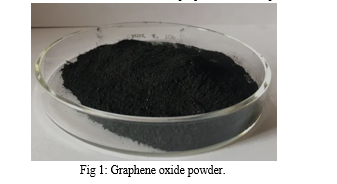
Furthermore, the potential applications of GO-infused cement extend beyond conventional construction. With its ability to conduct electricity, GO-modified cement opens doors to innovative solutions in infrastructure, such as self-sensing and self-healing concrete. These functionalities can enable real-time monitoring of structural health and autonomous repair of minor damages, revolutionizing the maintenance and longevity of civil engineering projects. In essence, the integration of graphene oxide into cement mixing represents a significant advancement with far-reaching implications for the construction industry and beyond.
The objective of this study is to explore the viability and effectiveness of Graphene oxide Powder as partial substitutes for cement. This involves extensive laboratory experiments and subsequent analysis.
B. Problem identification
One prevalent issue in concrete is its susceptibility to cracking and deterioration over time, often due to factors such as moisture ingress, chemical attacks, and structural stresses. Graphene oxide (GO) addresses this problem by reinforcing the concrete matrix at the nanoscale, thereby significantly enhancing its mechanical strength and durability. By forming a robust network within the concrete, GO reduces permeability, limiting the ingress of water and harmful substances. This reinforcement mitigates cracking and spalling, prolonging the lifespan of concrete structures and reducing the need for frequent repairs and maintenance. Consequently, the incorporation of GO into concrete not only addresses existing durability concerns but also contributes to the development of more resilient and long-lasting infrastructure systems.
II. LITERATURE REVIEW
- M. Devasena et al. looked on the strength characteristics of concrete using graphene oxide. They detailed the material's mechanical properties and calculated the ideal graphene oxide dosage required to maximise concrete strength. Three distinct amounts of graphene oxide (0.05, 0.1, and 0.2) were added to the concrete mixture to match to different cement concentrations. Before testing, all samples were allowed to cure for seven, fourteen, and 28 days, respectively. The findings showed that the concrete's tensile, flexural, as well as compressive strengths are improved by an inclusion of graphene oxide.
- In order to compare the mechanical properties of M25 grade concrete with those of graphene oxide concrete, Shareef, K. R. Mohammad et al. carried out a study. They specifically looked at the M25 grade concrete's split tensile and compressive strengths at 1% and 2% weight replacement with graphene oxide. 150 mm x 150 mm x 150 mm cubes were used to measure the compressive strength, and 150 mm in diameter x 300 mm length cylinders were used to measure the split tensile strength. The strength of these samples was assessed 28, 56, as well as 90 days following the curing procedure. According to the research, adding graphene oxide to concrete has a number of benefits over conventional concrete.
- Dahiphale Shubham et al.'s study investigated the application of wollastonite in place of cement, as much as thirty percent of the cement's weight replacement while keeping the water-to-cement ratio at 0.44. The results showed a significant improvement in compressive strength at 10%, 12.5%, as well as 15% wollastonite replacement rates as compared to the reference mixture. Particularly, 15% wollastonite replacement showed the most benefit.
- Wollastonite replaces a portion of the cement in concrete at 0%, 10%, 12%, 14%, 16%, and 18%, according to Supriya Xavier Lopes et al. Wollastonite's impact on the strength characteristics of concrete for the M30 grade mix is investigated. IS 10262 (2019) is employed in the Mix Design process. To gauge workability, compaction factor and slump are calculated. Flexural and compression strengths are calculated for different concrete compositions. By submerging the cubes in a solution of HCl and MgSO4 for 28 days, the durability of the cubes is assessed in terms of resistance to sulphate and chloride. The outcomes from different mix combinations are then contrasted with a standard concrete mix.
- Liu Changjiang, Huang Xiaochuan, Wu Yu-You, Deng Xiaowei, Liu Jian, Zhoulian Zheng, and Hui David. A novel kind of cement-based materials emerged in response to concerns for energy savings as well as conserving the environment, as well as rising demands for the functionality of cement-based materials in recent years. There has been a surge of studies on new materials due to the availability of concrete with excellent performance and more eco-friendly materials. Environmentally friendly geopolymers are becoming accessible to people of all ages. Cement-based materials' low toughness defects, usual energy usage, and environmental protection are all addressed. Conversely, current research has focused a lot of attention on nanomaterials. Thus, many academics are interested in learning more about the properties of cement-based materials, particularly those related to graphene as well as its derivatives modified geopolymers. Nanomaterials based on graphene is one of them. due to their superior physical characteristics and sizable specific surface area. A lot of researchers believe they are the finest. This study examines the effectiveness of graphene-based nanomaterials in improving the characteristics of cement-based as well as geopolymer materials, and especially the main obstacles to their further development in the construction industry.
III. MATERIALS USED
This study incorporates fundamental constituents of concrete, complemented by additional additives designed to improve both performance and sustainability. The subsequent sections provide a detailed exploration of the following materials:
A. Cement
Concrete relies on cement as its principal binding agent, providing strength and cohesion to the mixture. In this study, the selected material is Ordinary Portland Cement 53 grade, sourced from Ultra-tech Cement Company, and adhering to the standards outlined in IS 12269-1987.The physical properties of the cement are summarized in Table 1 below.
Table 1: cement properties.
|
S.NO |
PARTICULARS |
RESULTS |
|
1 |
Specific Gravity |
3.15 |
|
2 |
Initial setting time |
45 min |
|
3 |
Final setting time |
320 min |
|
4 |
Fineness of cement |
1.1 |
B. Fine Aggregate
Fine aggregate plays a crucial role in the world of concrete by occupying spaces left by coarse aggregate, which increases the matrix's overall strength and compactness. The natural sand used in this study's fine aggregate comes via the Vegavathi River in the Vizianagaram area, close to Vantaram. The sand's density in relation to water is indicated by its specific gravity, which is found to be 2.74.
Table 2: Fine Aggregate Properties
|
S.NO |
PARTICULARS |
RESULTS |
|
1 |
Type |
Normal sand |
|
2 |
Specific gravity |
2.74 |
|
3 |
Grading size |
4.75mm – 0.075mm |
|
4 |
Water absorption |
1% |
|
5 |
Fineness modulus |
2.8 |
These properties provide essential insights into the characteristics of the fine aggregate, guiding its selection and utilization in concrete mix design.
C. Coarse Aggregate
Because of its bigger particle size, coarse aggregate is essential for giving concrete mixtures solidity and body. The coarse aggregate used in this investigation is 20 mm-sized crushed granite aggregate. The coarse aggregate's specific gravity, or density in relation to water, is found to be 2.742.
Table 3: Sieve analysis of coarse aggregate
|
S.NO |
PARTICULARS |
RESULTS |
|
1 |
Type |
Crushed stone |
|
2 |
Specific gravity |
2.742 |
|
3 |
Maximum size |
20mm |
|
4 |
Water absorption |
0.5% |
|
5 |
Fineness modulus |
6.19 |
D. Design of M60 Grade (conventional Concrete)
- Grade Designation: M60
- Type of Cement: OPC 53 Grade Conforming to IS 8112
- Maximum nominal size of Aggregate: 20mm
- Minimum Cement Content: 320Kg/m3
- Maximum Water Content ratio: 0.45
- Workability: 100mm(slump)
- Method of concrete placing: Not pumping
- Degree of supervision : Good
- Type of aggregate: Crushed angular aggregate
- Maximum cement content: 450Kg/m3
- Chemical admixture type: Conplast SP 430
- Cement used: OPC 53 grade Conforming to IS 8112
- Specific gravity of cement: 3.15
- Chemical admixture: Superplaticizer conforming to IS 9103
- Specific Gravity for
- Coarse aggregate: 2.742.
- Fine aggregate: 2.74
- Water absorption1.
Coarse aggregate: 0.5 Percent
2. Fine aggregate: 1.0 Percent
- Free (surface) moisture
1. Coarse aggregate: Nil
2. Fine aggregate: Nil
G)Sieve analysis
1. Coarse aggregate: Conforming to Table 2 of IS 383
2. Fine aggregate: Conforming to Grading zone II of Table 4 of IS 383
Target Strength for Mix Proportioning
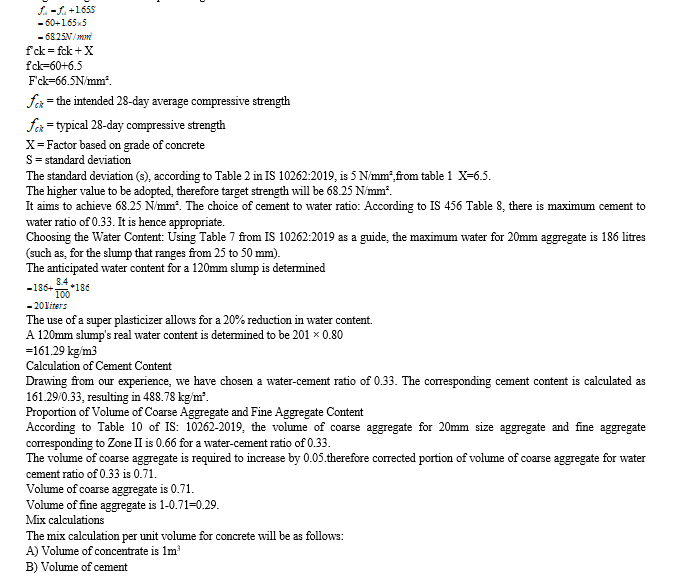
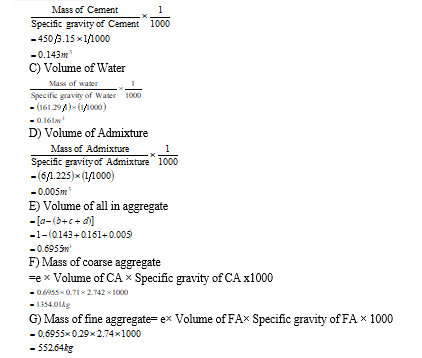
Table 4: Samples prepared for 1 m3 concrete.
|
|
|
S1 |
S2 |
S3 |
S4 |
S5 |
|
Cement |
Kg |
450 |
447.75 |
445.5 |
443.25 |
441 |
|
Water |
Liters |
161.29 |
157.73 |
157.73 |
157.73 |
157.73 |
|
CA |
Kg |
1354.01 |
1035.13 |
980.649 |
926.169 |
871.688 |
|
FA |
Kg |
552.64 |
806.58 |
806.58 |
806.58 |
806.58 |
|
Graphene oxide |
Kg |
0 |
2.25 |
4.5 |
6.75 |
9 |
The table presents five concrete samples with different weight ratios of cement, water, and aggregate, designed to attain a targeted compressive strength, often expressed as the characteristic strength, such as M60. In order to enhance specific properties of the concrete mix, supplementary materials, namely Graphene oxide, have been included. Notably, samples involve incorporating Graphene oxide at proportions of 0.5% to 2%, respectively, while simultaneously reducing the cement content.
- Mix Design of Concrete
The concrete mix formulation plays a critical role in obtaining the requisite durability and toughness while optimising material utilisation and cost. The proportions of the mix for M60 grade concrete are found by replacing the cement with different amounts of GO powder. A constant water-to-cement proportion of 0.35 is kept throughout the investigation. For the purpose of determining the compressive strength at seven, twenty-eight, as well as fifty-six days, permeability to chloride at 28 days specimens are cast in conventional cube moulds (150mm × 150 mm × 150mm), cylinders (150 mm diameter × 300 mm height), Blocks (150mm × 150 mm × 700 mm.
- Batching
Weigh batching method is adopted to measure the quantities of fine aggregate, cement, coarse aggregate Graphene oxide powder. This ensures accuracy and consistency in the proportions of ingredients for concrete mixtures.
- Mixing of Concrete
The ingredients are charged into a laboratory concrete mixer and mixed thoroughly until achieving a uniform color and workable consistency. Dry mixing of aggregates and cement is conducted for two minutes followed by gradual addition of water over a 30-minute mixing period.
- Casting of Specimens
Three layers of the concrete are carefully poured into conventional metallic moulds, and each layer is compressed with 25 blows from a tamping rod. The mould walls are coated with a thin layer of oil to make specimen removal simpler. The moulds are then vibrated for 30 seconds on a table vibrating device to guarantee complete compaction. The specimens' top surfaces are carefully treated after they have been compressed to produce a smooth texture.
Annexure 1 contains all the relevant information regarding specimen dimensions, qualities of different ingredients, and mix design. This all-inclusive strategy guarantees dependable and consistent experimental results, making the assessment of concrete mixtures with grapheme oxide powder.
Table 5: Specimen details
|
Mould type |
Dimensions |
|||
|
7 days |
28 days |
56 days |
||
|
Cubes |
150 mm*150 mm*150 mm |
5 |
45 |
5 |
|
cylinders |
150 mm dia*300 mm height |
5 |
5 |
5 |
|
blocks |
150 mm*150 mm*700 mm |
5 |
5 |
5 |
- Curing of Specimens
The concrete samples are demolded and labelled with the amount of grapheme powder, as well as their mixtures following a 24-hour air drying period. The specimens are then set aside in a water tank to cure. Curing is necessary to guarantee the formation of durability and toughness qualities, encourage hydration, and maintain appropriate moisture levels throughout the concrete. Before testing, every specimen is cured for the intended amount of time.

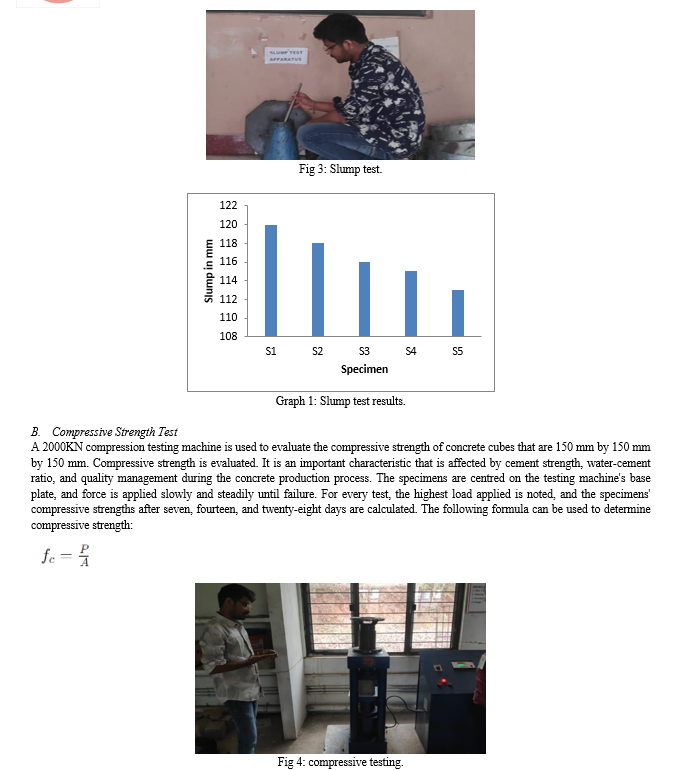

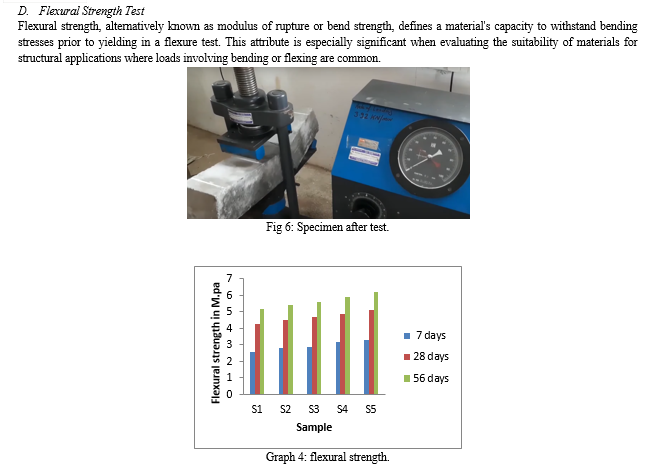
E. Acid attack testing
Acid attack testing is essential for evaluating the durability of concrete in aggressive environments, such as those containing sulfuric acid (H2SO4) or hydrochloric acid (HCl). The procedure typically involves subjecting concrete specimens to acidic solutions of varying concentrations and monitoring changes in mass and compressive strength over time. Firstly, specimens are prepared according to standard testing procedures and cured under water for a specified period to ensure proper hydration. Once cured, the specimens are dried and weighed to establish their initial mass.
Next, the specimens are immersed in acid solutions of predetermined concentrations, simulating exposure to acidic environments. 28 days are considered for curing. During immersion, the specimens are periodically removed from the solution, dried, and weighed to assess changes in mass over time. Additionally, compressive strength tests may be conducted on the specimens before and after acid exposure to evaluate the degree of degradation. The results of acid attack testing provide valuable insights into the resistance of concrete to chemical deterioration and inform the selection of appropriate materials and protective measures for structures in corrosive environments.
|
|
S1 |
S2 |
S3 |
S4 |
S5 |
|
Before |
8.21 |
8.33 |
8.22 |
8.19 |
8.21 |
|
After |
8.01 |
8.05 |
8.06 |
7.88 |
7.79 |
|
% loss of wt |
2.4 |
3.4 |
1.9 |
3.8 |
5.1 |
|
Fck |
58 |
60 |
62 |
63 |
64 |
|
F1ck |
46 |
50 |
53 |
54 |
55 |
|
% of loss of strength |
20.7 |
16.7 |
14.5 |
14.3 |
14.1 |
Table 6 : Compressive strengths after acidic environment (H2SO4) at 28days
fck =Average Compressive Strength after 28 days water curing f l ck = Average Compressive Strength after 28 days curing in H2SO4.
HCl Percentage weight loss and percentage loss in compressive strengths for all mixes as shown in table
|
|
S1 |
S2 |
S3 |
S4 |
S5 |
|
Before |
8.23 |
8.42 |
8.34 |
8.25 |
8.33 |
|
After |
7.81 |
7.99 |
7.95 |
7.84 |
7.78 |
|
% loss of wt |
5.1 |
5.1 |
4.7 |
5.0 |
6.6 |
|
Fck |
58 |
60 |
62 |
63 |
64 |
|
F1ck |
48 |
53 |
55 |
55 |
57 |
|
% of loss of strength |
17.2 |
11.7 |
11.3 |
12.7 |
10.9 |
Table 7: Compressive strengths after acidic environment (HCl) at 28days
fck =Average Compressive Strength after 28 days water curing f l ck = Average Compressive Strength after 28 days curing in HCl
Sulphate attack:
MgSO4 Percentage weight loss and percentage loss in compressive strengths for all mixes as shown in table
|
|
S1 |
S2 |
S3 |
S4 |
S5 |
|
Before |
8.23 |
8.42 |
8.34 |
8.25 |
8.33 |
|
After |
8.21 |
8.34 |
8.25 |
8.2 |
8.26 |
|
% loss of wt |
0.2 |
1.0 |
1.1 |
0.6 |
0.8 |
|
Fck |
58 |
60 |
62 |
63 |
64 |
|
F1ck |
57.2 |
58.1 |
59.5 |
61 |
62 |
|
% of loss of strength |
1.4 |
3.2 |
4.0 |
3.2 |
3.1 |
Table 8: Compressive strengths after Sulphate environment (MgSO4) at 28days
fck =Average Compressive Strength after 28 days water curing f l ck = Average Compressive Strength after 28 days curing in MgSO4.
Na2SO4 Percentage weight loss and percentage loss in compressive strengths for all mixes as shown in table
|
|
S1 |
S2 |
S3 |
S4 |
S5 |
|
Before |
8.21 |
8.33 |
8.22 |
8.19 |
8.21 |
|
After |
8.15 |
8.28 |
8.15 |
8.12 |
8.18 |
|
% loss of wt |
0.7 |
0.6 |
0.9 |
0.9 |
0.4 |
|
Fck |
58 |
60 |
62 |
63 |
64 |
|
F1ck |
50 |
54 |
56 |
57.5 |
58 |
|
% of loss of strength |
13.8 |
10.0 |
9.7 |
8.7 |
9.4 |
Table 9:Compressive strengths after Sulphate exposure (Na2SO4) at 28days
fck =Average Compressive Strength after 28 days water curing f l ck = Average Compressive Strength after 28 days curing in Na2SO4.
Conclusion
The experimental results shed light on the mechanisms causing strength increase and potential limitations, offering significant insight into the impact of GO on concrete strength parameters. The analysis takes into account variables like pozzolanic activity, hydration properties, and GO-influenced microstructural alterations. The findings show a direct relationship between compressive strength and GO concentration, a greater GO content corresponding to stronger outcomes. Notably, the maximum strength obtained from the GO-enhanced sample is 8.77% higher than that of the conventional concrete in the seven-day compressive strength findings, demonstrating the effectiveness of GO as a concrete strengthening agent. Furthermore, the study examines the flexural and tensile strength properties of the concrete specimens, revealing similar trends of enhancement with increasing GO concentration. The data highlight the potential of GO to improve not only compressive strength but also tensile and flexural strength, critical for various construction applications. However, the study also identifies potential challenges, such as the loss of strength under acidic environments. Acid attack tests indicate a decrease in compressive strength for GO-enhanced samples exposed to sulfuric acid and hydrochloric acid, underscoring the need for further research to address durability concerns in specific environmental conditions. Overall, the experimental findings contribute to the growing body of knowledge on GO-enhanced concrete and its potential applications in construction. While the results demonstrate promising improvements in strength properties, further investigation is warranted to understand the long-term durability and performance of GO-enhanced concrete in real-world conditions. Addressing challenges related to environmental durability and optimizing GO concentration and dispersion will be crucial for realizing the full potential of this innovative additive in construction materials and infrastructure.
References
[1] IS 10262 (2019), “Concrete Mix Proportioning– Guidelines”, Bureau of Indian Standards, New Delhi, India. [2] IS 456 (2000), “Plain and Reinforced Concrete–Code of Practice”, Bureau of Indian Standards, New Delhi, India. [3] Zhou Fan, M.S. University of Pittsburgh, (2014) ‘Investigation On properties Of Cementitious Materials Reinforced by Graphene. [4] Ahmadreza Sedaghat, A. Zayed, (2014) “investigation of physical properties of graphene cement composite for structural application”. [5] Abolfazl Hassani, Babak Fakhim, AlimoradRashidi,ParvizGhoddousi (2014) “The influence of graphene oxide on mechanical properties and durability increases of concrete pavement”. [6] Jose Luis Fraga, Jose María del Campo, and Juan Ángel García (2014). “Carbon nanotube cement composite in the construction industry: 1952-2014. A state-of-the-art review”. [7] Fakhim Babak, Hassani Abolfazl (2014) \"Preparation and Mechanical Properties of Graphene Oxide: Cement Nanocomposites\". [8] M. Devasena and J. Karthikeyan (2015).\"investigation of strength properties of graphene oxide concrete”. [9] Dahiphale,Baig Abdullah Al Muhit, Boo Hyun Nam, Lei Zhai,JosephZuyus (2015) “effect of microstructure on the compressive strength of graphene oxide cement composites”. [10] Mohammohamad, med, J.G. Sanjayan, W.H. Duan, A. Nazari (2015) “incorporating graphene oxide in cement composite: a study of transport properties”.
Copyright
Copyright © 2024 Velamuri Sai Vikas, Anusuri Uma Maheswari. This is an open access article distributed under the Creative Commons Attribution License, which permits unrestricted use, distribution, and reproduction in any medium, provided the original work is properly cited.

Download Paper
Paper Id : IJRASET63079
Publish Date : 2024-06-03
ISSN : 2321-9653
Publisher Name : IJRASET
DOI Link : Click Here
 Submit Paper Online
Submit Paper Online

